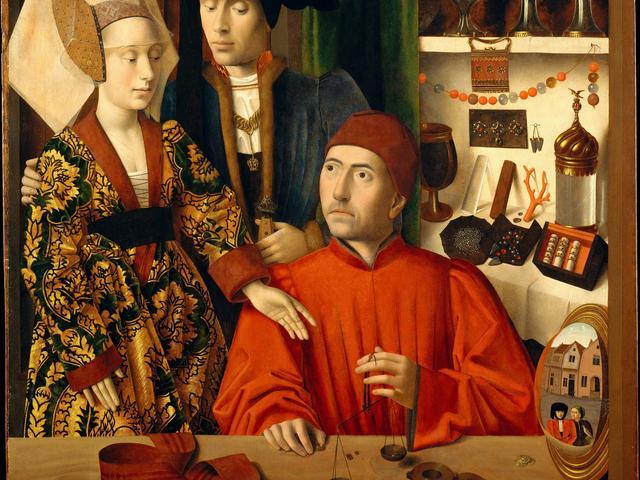A goldsmith in his shop, possibly Saint Eligius

Like many other Northern Renaissance paintings, Petrus Christus's Goldsmith in his Shop reveals its intricacies to the viewer over time. At the beginning, one sees a group of three people inside a room full of trinkets. The two standing figures, a man and a woman dressed in rich, expensive-looking clothing, appear to be a couple, as the man has his arm wrapped around the woman's back. This woman gestures with her left hand toward the seated man, who, dressed in a plain red garment with a matching hat, looks at the woman. On her left hand, she has a small balance holding a gold ring (fans of Northern art will recognize this as a small scale much like the one that appears much later in Vermeer's Woman Weighing Gold, 1662-1663). In fact, the figures are inside a gold shop, and the man is a goldsmith. The ornaments on display: objects made of precious metals, stones, glass and coral are their products, and the couple standing is probably about to make a purchase.
The artistic concerns of Petrus Christus are typical of the painters of his time. The detail of the trinkets in the store, as well as the luminosity of the painting, are only possible due to the use of oil paint, which was not common in Italy until many years later.
Petrus Christus was an early Dutch painter active in Bruges from 1444, where, together with Hans Memling, he became the leading painter after the death of Jan van Eyck. He was influenced by van Eyck and Rogier van der Weyden and is noted for his innovations with linear perspective and a meticulous technique that seems derived from miniatures and manuscript illumination. Today about 30 works are confidently attributed to him. The best known include the 1446 Portrait of a Carthusian and c. 1470 Berlin Portrait of a Young Girl, both are highly innovative in presenting the figure against detailed, rather than flat, backgrounds.
Christus was an anonymous figure for centuries, whose importance was not established until the work of modern art historians. Giorgio Vasari barely mentions it in his biographies of painters, written in the Renaissance, and almost contemporary records simply list it among many others. In the early to mid-19th century, Gustav Waagen and Johann David Passavant were important in establishing biographical details of Christus and in attributing works to him.
© Tourblink